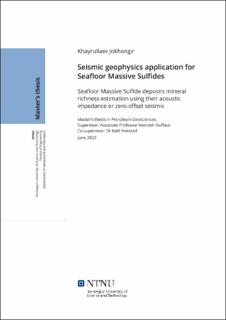| dc.description.abstract | Seafloor massive sulfide deposits are generated in tectonically active areas such as the back-arc spreading centre, volcanic arc, and mid-ocean ridges. Seafloor massive sulfide deposits form at or near the seafloor surrounded by host-rocks. Seafloor massive sulfide deposits contain ore bodies consisting of more than 40 % of sulfides, such as Pyrite, Pyrrhotite, Chalcopyrite, Sphalerite, and Galena minerals, containing a significant amount of Copper, Zinc, Iron, Lead, Gold, Silver that are necessary for many purposes, especially for transition to renewable energy sources that creates the need for their assessing their mineral richness nowadays. Seismic geophysics is a lucrative tool for this purpose thanks to big areal coverage and the possibility of deep imaging subsurface with satisfactory resolution at a relatively low cost. Based on previous research work on Seafloor massive sulfides rock physics during the author’s specialization project, an assumption that it is not possible to estimate Seafloor massive sulfide mineral richness from its acoustic impedance alone and consequently from zero-offset or near-stack seismic data has been developed. This assumption is examined on real data from Trans-Atlantic Geotraverse Seafloor massive sulfide field. Trans-Atlantic Geotraverse Seafloor massive sulfide field is located on Mid-Atlantic Ridge at 26°9’N, 44°48’W and it is one of most studied Seafloor massive sulfide fields in the world where 2D reflection seismic profiles are recorded and set of core samples are collected. Core com position analyses, P-wave velocity measurements in the core and core bulk density measurements are performed in the laboratory. Existence of several Seafloor massive sulfide deposits located near seabed at Trans-Atlantic Geotraverse Seafloor massive sulfide field is proved during several scientific expeditions. Active Trans-Atlantic Geotraverse mound is one of those Seafloor massive sulfide deposits. During this work, firstly, the relation between the acoustic impedance and mineral richness of the Active Trans-Atlantic Geotraverse mound is examined. The acoustic impedance of the Active Trans-Atlantic Geotraverse mound is obtained using model-based inversion and calculated, from P-wave velocity measurements and bulk density measurements of cores from a shallow hole for this purpose. Secondly, the relation between the seismic amplitudes on the seabed and the mineral richness of the Active Trans-Atlantic Geotraverse mound is investigated. | |
